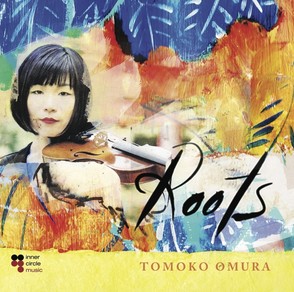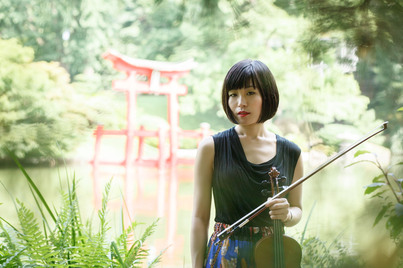
I first heard her when she was the violinist for the Celtic group "RUNA," a fine band with wonderful writing and musicianship. Tomoko grabbed my attention immediately with her precision and power. I discovered her 2009 album "Visions" and was hooked for good.
In the liner notes of "Roots," her mentor and Berklee instructor Christian Howes tell a bit of her story: "It's hard to believe that within just the last ten years Miss Omura came to the U.S. from Japan and has already emerged as a proven powerhouse, one of the top calls in NYC on her instrument.
It might have been easier to stay in Japan and study Youtube videos... Instead, she learned a new language, made her way to one of the leading schools of Jazz at Berklee, and worked against the odds to ensconce herself in NYC amongst a community of world class young players who help to execute her exotic vision with perfect clarity on this recording."
Those "world class young players" include Will Graefe (who has brilliant solo work as well as touring with other bands) on guitar, Glenn Zaleski (a 2011 semi-finalist at the International Thelonious Monk Competition and whose trio has played with Ravi Coltrane) at piano/keys, Noah Garabedianan (an ethno-musicologist from UCLA) on double bass and Colin Stranahan (who also fronts his own trio) on drums. With Tomoko, these guys bring the goods.
"Roots" in a Jazz exposition of some of Japan's most beloved traditional songs. The Jazz interpretation of traditional music is something that may bother purists but--again in Howes' liner notes--"Whether you are a purist or a progressive proponent of the globalization of Jazz, Tomoko Omura's offering here, both informed and boldly creative, commands your attention."
That Jazz adaptation has received growing attention through the works of artists like the splendid Eugene Marlow has done with his Heritage Ensemble's release of the 4-volume series "In Their Own Voice" which gives a Jazz spin on traditional Jewish songs.
What sets Tomoko apart is the overlay of tradition on Jazz. There is arrangement and assimilation, to be sure, but from the opening track--"Antagata Dokosa (Where Are You From?)"--Tomoko herself sings the traditional greeting while beneath can be heard the very Jazz movement of the rest of the band. The piece transitions from vocal charm to instrumental brilliance.
Noah Garabedianan begings on double bass with Colin Stranahan picking up the rhythm. When the whole group joins in, it sounds like Jean-Luc Ponty at his finest...and it doesn't get much better than that.
Tomoko can absolutely bend the violin to her will. With whatever technique she employs, she creates the sound and mood of her own desire and the results are scintillating. The musicians with her leave nothing unexplored and nothing left to be desired.
The second track, "Ge Ge Ge," is playful and fun. "Gegegeno Kitarou" was a manga series created in 1959 by Shigeru Mizuki based on an early 20th century folktale. Mizuki's manga has been the subject of several television shows, live action productions, anime and video games. A popular daytime drama appeared on Japanese TV in 2008 called "Gegege's Wife." This track was composed by Taku Izumi and arranged by Tomoko. Mizuki's characters practically leap off the CD in Tomoko's treatment.

It is not too much to say that Colin Stranahan has provided the best rhythmic support that I have ever heard on a violin album. This man has the intuition and the innovation and Tomoko's album is the fortunate beneficiary of his uniquely brilliant work.
Noah Garabedian's bass work sets off the next track "Kojo No Tsuki (Castle in the Moonlight)" with understated movement and elegance.
It is too easy to overlook Garabedian's contributions as he maintains such elegance beneath the melodic work of Tomoko and Zaleski. He deserves attention.
"Kojo No Tsuki" is one of the most Impressionistic pieces on the album. The imagery is vivid and electrifying as Tomoko paints this splendid Jazz nocturne. If Corelli was the "iconic reference point" for 18th century violinists, surely Tomoko Omura has a great chance to become such for this generation of growing Jazz violinists. This track alone is a viable suggestion for that.
"Tinsagu Nu Hana (Balsam Flowers)" is a traditional song from Okinawa, one of Japan's southernmost islands. The Balsam flower is a quick-blooming Summer flower and Tomoko creates that very image here. The song actually flowers like the Balsam, beautifully blossoming and gone far too soon. Will Graefe's guitar interlude is extraordinary and flows splendidly with the course of the song.
"Cha Tsu Mi (Green Tea Picking)" opens with the sound of tea being stirred and poured accompanied by Tomoko's strumming and picking. It is lively and entirely enjoyable. Zaleski's accompaniment to Tomoko's violin is sterling and his solo is spot on. Think of any interesting Jazz piano solo you have ever heard and put this one alongside it. Yeah, he's that good.
And Tomoko's own bow-breaking attack is marvelous. This truly is a remarkable group who know how to follow a fantastic leader.
Succeeding that romp is "The Mountain" by Chuji Kinoshita. It is majestic and it is reverent. It puts one in mind of Rudolf Otto's concept of the "numinous" from "Idea of the Holy." It is movingly Impressionistic with its watercolor running of images. The brooking of Zaleski's piano runs and the soaring of Tomoko's violin both run atop a rock-hard foundation from Garabedian and Stranahan. Exemplary Jazz.
"Soran-Bushi" is an old sea shanty work song from Hokkaido, Japan's northernmost of the four main islands. The skittering movement of the violin opening immediately call to mind the sea gulls mentioned in the fishermen's song. The English translation says: "When we hear the jabbering of seagulls on the high seas, we know we can’t give up our fishing lives on the ocean."
There is a distinct nautical feel to the swelling movements of the piece. Graefe's guitar is punctuating and rollicking alongside the violin while piano, bass and drums captivate the listener.
"Chakkiri-Bushi" is a traditional song from Tomoko's home of Shizuoka. There is a traditional instruments version of the piece with shakuhachi (wood flute) and shamisen (three-stringed instrument) found on the Internet at http://www.komuso.com/pieces. Listen to what Tomoko has done with that and be impressed. Jazz expansion and arranging at its best.
All the musicians get ample spotlight on this fantastic interpretation of the Shizuoka song. If it seems that Tomoko has thrown all of herself into this piece, who can blame her for highlighting a song from home? The song seems full of Tomoko's best memories of her birthplace and it makes you want to visit there. (Try the Wasabi ice-cream. At least once. It's the only place in the world where you can get it.)
That track is appropriately followed by "Hometown" by Teiichi Okanao. The Japanese title is "Furusato" and the lyrics of the piece were written by Tatsuyuki Takano and they read:
"Sometimes I dream I'm on the Hill
Chasing the wild hare - freely at will
Catching small fish - as the Brook murmurs by
Place of my birthright - for you I sigh
Father and Mother - once you taught me
That treasures of life - are all given free
Friendship and happiness - Sunshine and Rain
Your words come back to me time and again
Clear crystal brooklet - fresh Hills of Blue
Whisper across the Breeze - where are you?
when fortune smiles on me - then Furusato
I will return to you, I love you so!"
Tomoko's piece portrays exactly that sentiment. It is full of longing and memory and the ever=present desire to see home again.
This astonishing album comes to a close with the reprise of "National Anthem." It is only a one-minute reprise but it a great wrap-up. Tomoko offers a fond "jaa ne" to Japan and home.
The leap from 2009's "Visions" to 2015's "Roots" is astounding. Her tenure with RUNA and with Carte Blanche and her debut solo album have shaped and sharpened Tomoko Omura's incredible talent that allowed her to create what may already be my choice for Best Album of 2015. It will difficult for anyone to remove her from that spot as of now.
Tomoko Omura has gathered like-minded and incredibly gifted musicians around her for this lovely and lively look homeward. It is full of life, fun and memory and it sets an anguished heart to rest. This album is what modern Jazz is meant to be.
Visit Tomoko Omura's official website here: http://www.tomokoomura.com/
Like her on Facebook here: https://www.facebook.com/tomoko.omura.18
Purchase "Roots" on MP3 or CD by clicking on the Amazon links below:
|
|
|
 RSS Feed
RSS Feed
